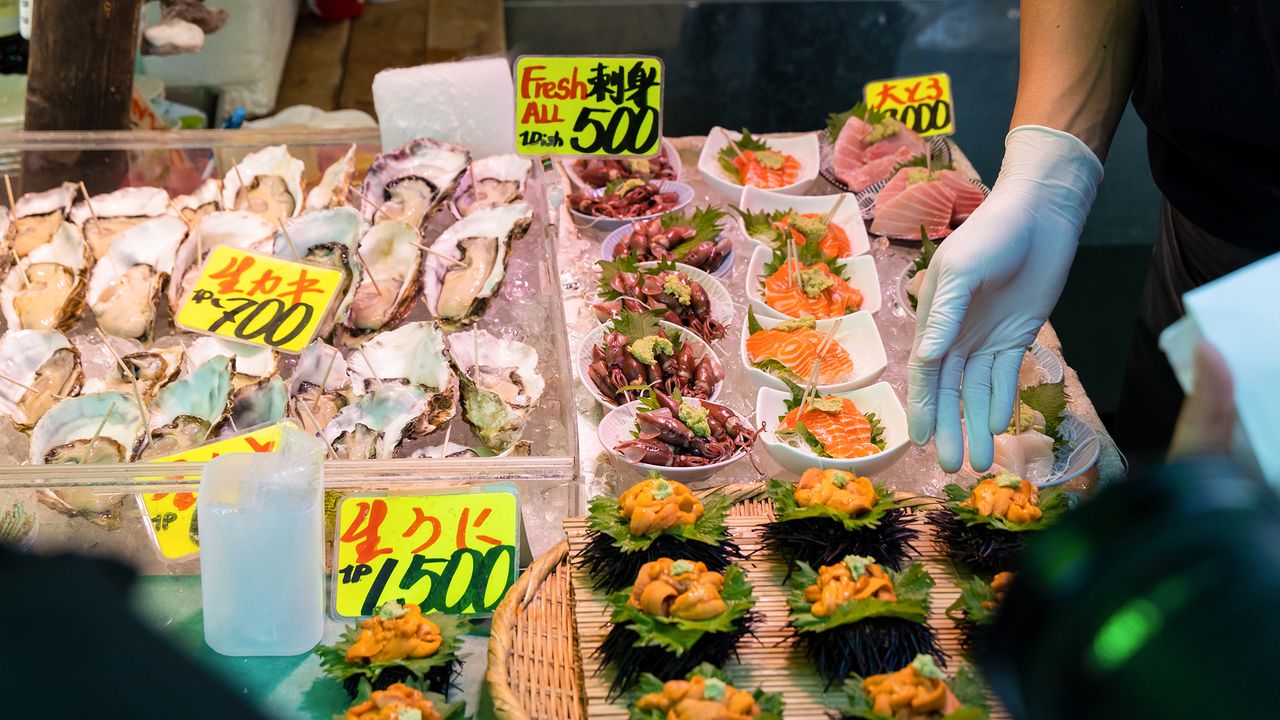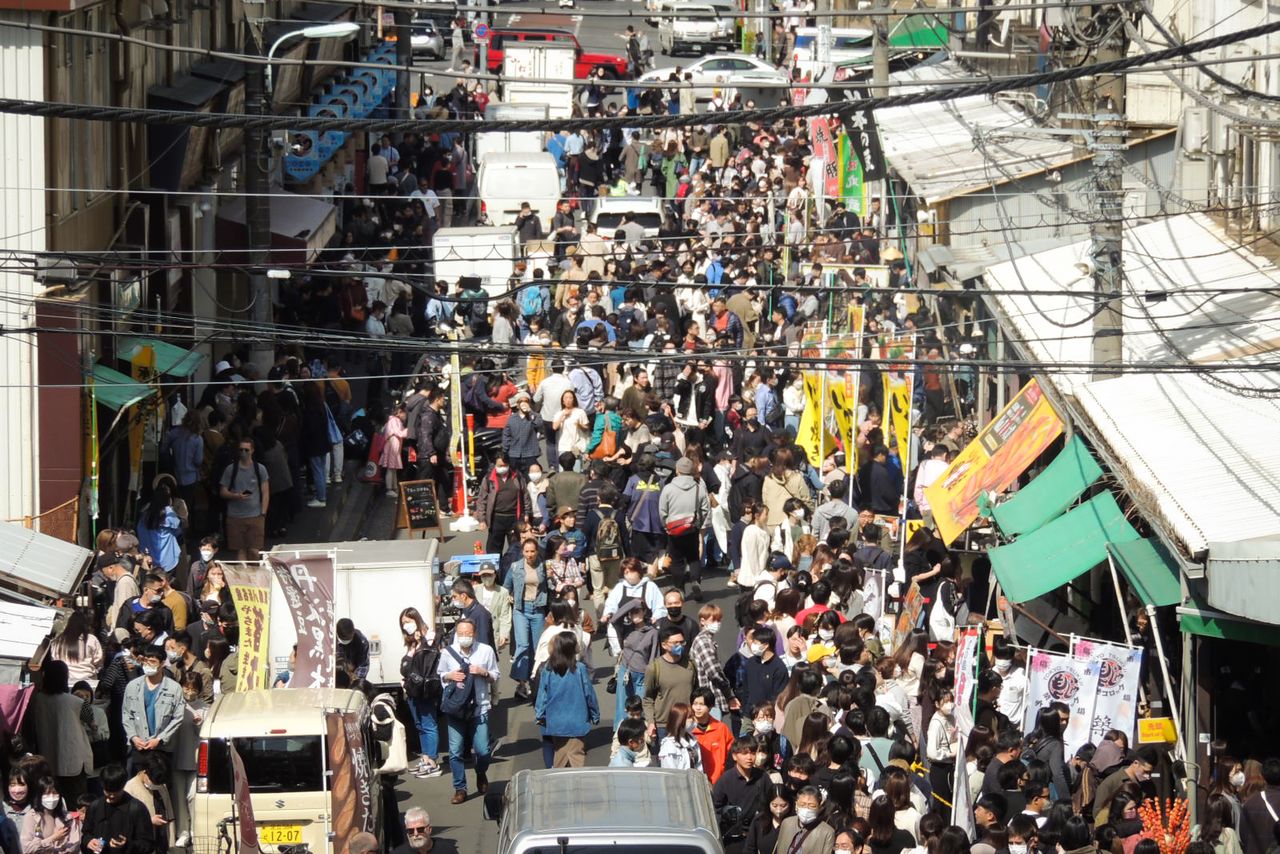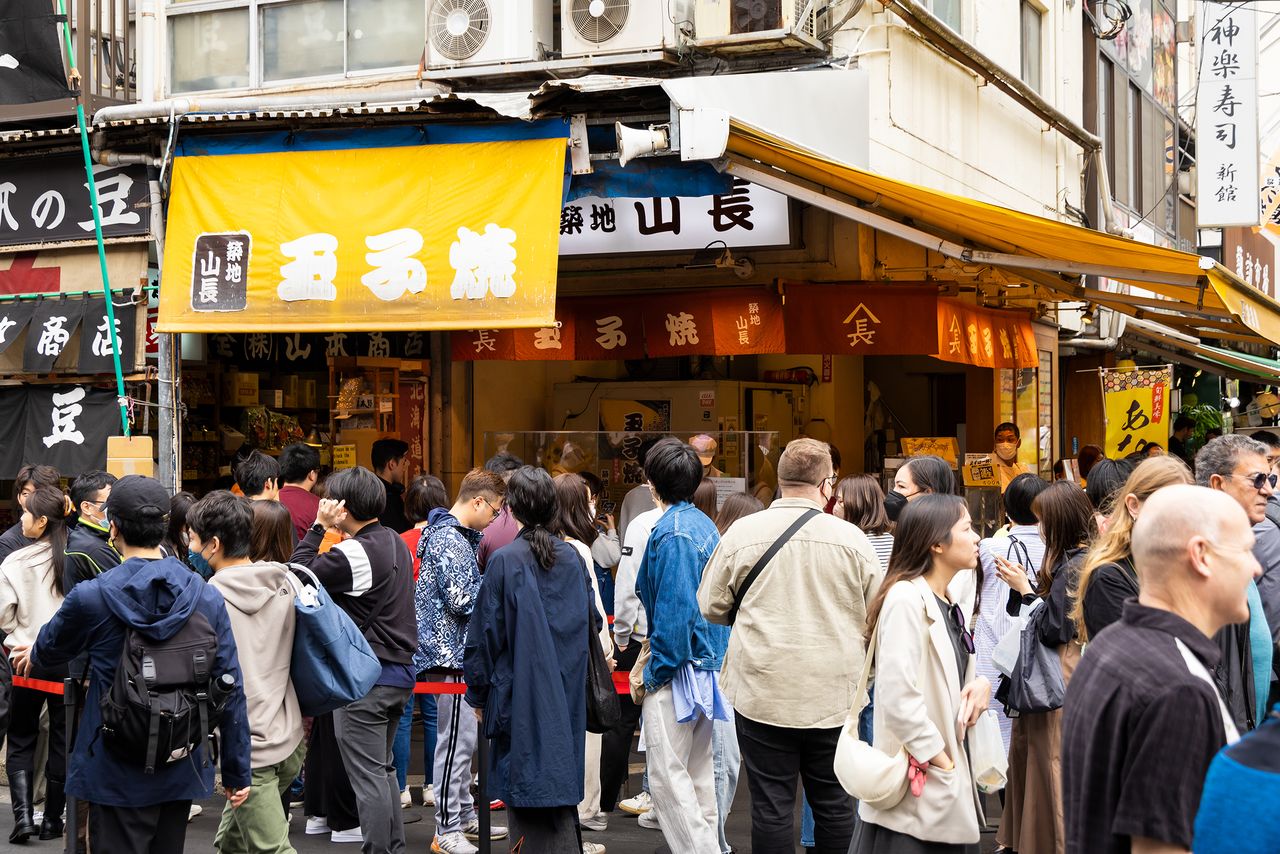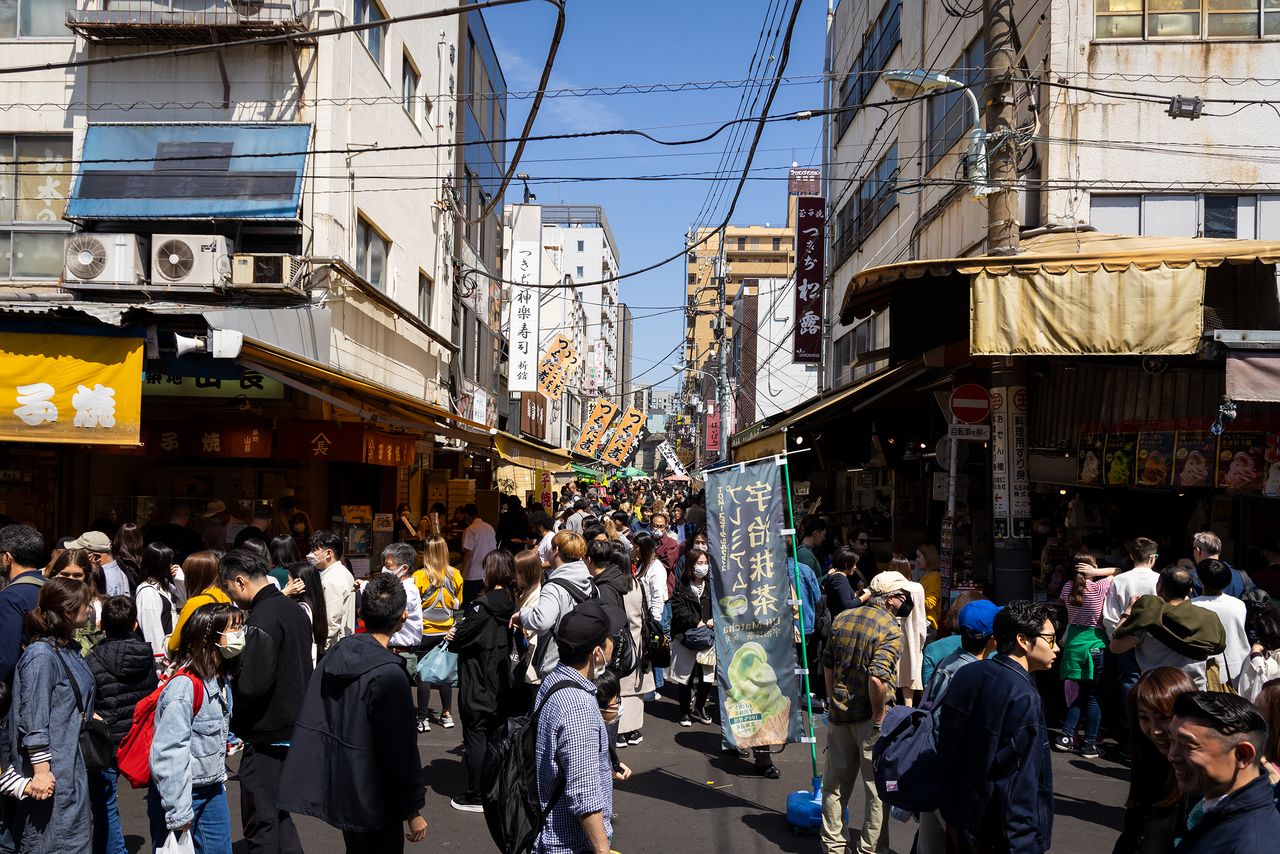
Tokyo’s Kitchen: Tsukiji’s Outer Market Enjoying Renewed Popularity
Guideto Japan
Food and Drink Travel- English
- 日本語
- 简体字
- 繁體字
- Français
- Español
- العربية
- Русский
Visitors Are Back!
Staff at the Plat Tsukiji tourist information center in Tokyo are all smiles these days, kept busy by the renewed influx of visitors to Tsukiji’s iconic outer market. “Compared to the height of the pandemic, when we just a handful of people would drop in each day,” says a staff member, ”we now see three or four hundred people daily, which keeps us on our toes.”
As the pandemic abated, visitors, many from abroad, once again made a beeline for Tsukiji. Tourist information center staff believe that the influx is due to pent-up travel demand from overseas and the expanded reach of social media attracting customers to popular shops in the market.

The Tsukiji outer market’s main street is thronged with visitors on weekends. This photo was taken from the passageway leading to Tsukiji Uogashi fish market, a new facility created after the inner market relocated to Toyosu.

The Plat Tsukiji tourist information center sets on Namiyoke avenue, which borders the Tsukiji outer market.
A well-known shop is Yamachō, a purveyor of Japanese-style rolled omelet. Located just across the street from the information center, it draws long lines of customers who come to buy kushidama, a distinctive “omelet on a stick” that is a favorite snack among visitors. Sales have boomed thanks to the increase in foreign travelers, for whom Yamachō is a “must” stop. On a typical day, the shop will sell out of its daily production of 2,000 omelets.

The line outside Yamachō is always long, but watching workers cook the omelets provides a diversion that makes time fly.

Sweet omelet on a stick makes the perfect dessert after enjoying seafood delicacies on offer in the outer market.
Twin Blows to Tourism
After the Tsujiki wholesale market relocated to Toyosu in 2018, the outer market, consisting of retailers and wholesalers open to the public, undertook a publicity blitz to spread the word that it was still operating and would stay put.
The wholesale market at Tsukiji replaced the Nihonbashi fish market, which was destroyed in the 1923 Great Kantō Earthquake. The new market was built on government-owned land, with a wholesale fruit and vegetable operation added in 1935. Officially the Tokyo Central Tsukiji Wholesale Market, it was known best simply as Tsukiji. The area to the northeast of the site had previously been the cemetery of the temple Tsukiji Honganji, but the graves were relocated after the earthquake. Shops selling fish, seafood, and kitchenware, and eateries for inner market workers moved into the vacated area, creating what today is known as the Tsukiji outer market.
Unlike the inner market, which was open only to the wholesale trade, the outer market caters to anyone and everyone, selling a variety of items, including fresh fish and seafood, dried ingredients essential for Japanese cuisine, and restaurant supplies. The area soon caught the attention of the general public, who would flock there especially at the end of the year to buy delicacies for New Year celebrations. The outer market also became a popular destination for visitors from abroad starting in the 1980s, fueled in part by sushi’s growing popularity overseas.

Monzeki-dōri, which runs parallel to main avenue Shin Ōhashi-dōri, is crowded with popular shops offering an array of succulent dishes.
When the inner market relocated to Toyosu in October 2018, outer market businesses worried that the move would drain away customers. But Chūō, the Tokyo municipality where Tsukiji is located, took steps to retain its vitality, including building Tsukiji Uogashi, a new facility where some 60 businesses, many of them operated by intermediate traders based at Toyosu, set up shop. Tsukiji Uogashi is popular with ordinary shoppers seeking the best-quality fish or seafood in season as well as with restaurant operators, who find it convenient because it is closer than Toyosu. It also attracts visitors from abroad, who often visit after shopping or seeing a kabuki performance at the Kabukiza in nearby Ginza.
However, the COVID-19 pandemic severely impacted tourism. The nearly 500 outer market shops saw sales drop as foot traffic dried up and antivirus measures forced them to cut their hours, forcing many out of business.

Tsukiji Uogashi consists of two connected structures, the Odawarabashi Building on Harumi-dōri and the Kaikōbashi Building on Namiyoke-dōri.

The former site of the Tsukiji inner market, viewed from the roof of the Tsukiji Uogashi’s Kaikōbashi Building.
Visitor Numbers Rising
Since autumn 2022, when Japan loosened its pandemic-related entry restrictions, the outer market has seen a steady uptick in foreign visitors. The weak yen has been an added incentive, and travelers, many of them repeat visitors to Japan, have headed to popular shops featured on social media. In the run-up to the New Year season, much to the relief of area shopkeepers, the outer market was as jampacked and lively as ever.
In past years, there was a marked drop-off in foot traffic in the outer market in early January after the inner market’s first auctions of the year. That trend has completely reversed itself, with even more people visiting than when the inner market was at Tsukiji.

The streets of the outer market teem with visitors.
The return of visitors to the outer market has brought a change in clientele to many of the long-established shops. Market workers and people from nearby office buildings formed the customer base of popular eateries on Monzeki-dōri like Yamachō, donburi purveyor Kitsuneya, and ramen shop Wakaba. Today, though, patrons include Japanese and foreign visitors alike who are drawn by rave reviews of shops posted on social media.
Even at local rice ball shop Marutoyo on Namiyoke-dōri, visitors consisting of a mix of foreign tourists and Japanese office workers form long lines from the early morning. The shop offers 40 kinds of onigiri, the most popular is filled with fatty salmon belly. It sells hundreds of its rice balls and tekkamaki tuna sushi rolls every day.

Early morning lineup at Marutoyo, which opens at 5:00 am.

The fatty salmon belly onigiri is the shop’s specialty and often sell out before noon.
A Bite of Sashimi?
Especially popular among the outer market’s selection of fare are single-portion plates of sashimi and mini rice bowls topped with seafood. Outer market stores affiliated with intermediate wholesalers normally sell to restaurants, but during the pandemic business all but dried up. Shifting their focus, they are now catering more to ordinary consumers, and some, eyeing the lucrative tourist trade, have begun attracting customers with tasty dishes that can be casually enjoyed.
Saitō Suisan, which specializes in high-end delicacies like bluefin tuna, rockfish, red bream, sea urchin, and horsehair crab, has long supplied restaurants and sushi bars. But lately it has started offering various types of sashimi in small portions that visitors can quickly savor with a dab of soy sauce and wasabi. Long lines of eager gourmets snake outside the shop on a daily basis.
Saitō Suisan’s owner says the small dishes allow visitors to sample a variety of delicious fish, including tuna, red seabream, and amberjack, with each dish priced at a very reasonable ¥500.

The storefront display at Saitō Suisan.

Plates of medium-fatty tuna and seabream can be had for just ¥500.
Seafood shop Aeya also sells small portions of sashimi for ¥500, and on weekends it offers a seafood bowl chock-full of the choicest ingredients. Other succulent fare includes nigiri zushi made with tuna, sea urchin, and red sea bream, as well as conger eel and kohada from Tokyo Bay.

Aeya is staffed by former Tsukiji inner market tuna auctioneers who source their wares at Toyosu.

An assortment of medium-fatty tuna and sea urchin, priced at ¥500 per piece.

Mini bowls with sea urchin (foreground) and tuna.
Fruits Also a Popular Draw
The Tsujiki outer market is worth a visit for foodstuffs other than seafood too. Japanese fruits have garnered attention for their high quality, and visitors can regularly be seen snapping up packs of goodies like ripe strawberries. Tsukiji may not be strongly associated with fruits, but the former Tsukiji inner market had a produce department, since moved to Toyosu, that handled fresh wares from all over the country.
In April, Yamashō Shōten, which sources strawberries from Toyosu, featured the Yuki Usagi variety of white strawberries, a specialty of Saga Prefecture. Looking as though they have been coated in condensed milk, these berries have a pleasingly tart flavor. Here too, customers can taste strawberries and juicy melon conveniently sliced into individual portions.

A box of giant white Yuki Usagi strawberries.

Visitors can purchase whole fruit or enjoy smaller portions.
Other interesting products abound. The shop Aji no Hamatō is known for its lineup of surimi, made from minced seafood paste, and saikyō-zuke, fish marinated in sweet Kyoto-style miso. Perfect for eating on the spot are its deep-fried satsuma-age and sister product corn-filled morokoshi-age. Another shop, Fuji Ham Shōkai, grills wagyū beef on the spot, its tantalizing aroma filling the air all day long.
In the past, customers typically came to the Tsukiji outer market either to eat or to shop for food items to take home. These days, however, the line is less clear-cut, as people stop for a bite to eat after a round of shopping for ingredients and souvenirs. The outer market’s atmosphere has changed over the past few years, and visitors now show interest in sampling various foods. It is common to see shoppers walking along while nibbling on sashimi and fish paste products, enjoying onigiri or seafood bowls, and choosing sweet dumplings or fruit for dessert.
An official from a local non-profit group sounds a note of caution, though. While the outer market is prospering as never before, the influx of visitors is leading to concerns about crowding and littering. Teaming up with local authorities, the group is working to ensure that everyone has a safe, enjoyable experience visiting the Tsukiji outer market.

At Aji no Hamatō, minced tuna and salmon cutlets are popular choices, along with the shop’s signature morokoshi-age.

Customers can have their wagyū beef grilled on the spot at Fuji Ham Shōkai.
(Originally published in Japanese. All photos by Nippon.com. Banner photo: Several varieties of sashimi, along with sea urchin and raw oysters, on display at Saitō Suisan.)
Related Tags
tourism Tokyo cuisine Tsukiji seafood restaurant Tsukiji Honganji
